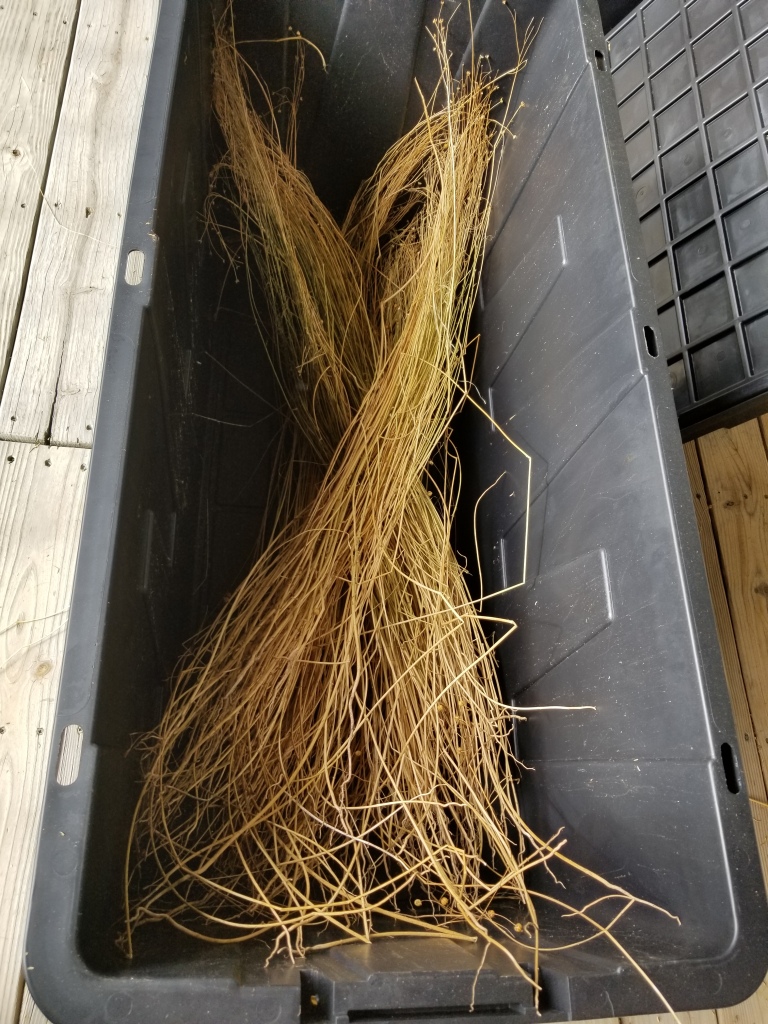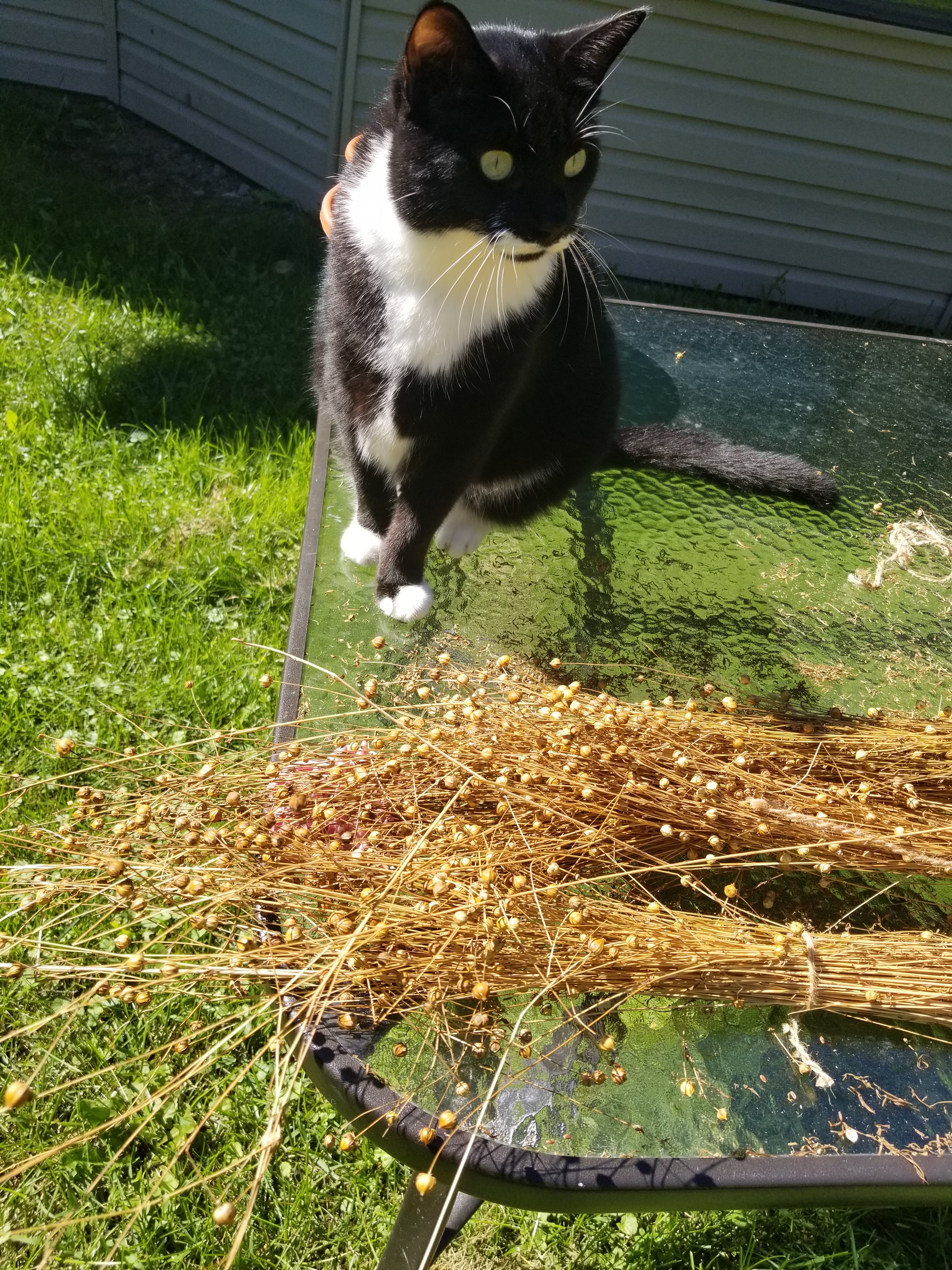In 2019, I planted a 10 x 10 plot of flax as part of a longterm project to weave a sail. I am starting from a very soft learning space. The number of steps ahead is huge- not the least of which is researching how historic sails were made!
But first- flax. I’ve grown two patches for this project. One in 2019 and the other in 2021.
Growing Flax 2019
Bob built two 8′ x 8′ garden boxes in 2019, but really, how many tomatoes can one household eat? The second box was a natural place to test out growing flax. The seeds came from the Landis Valley Museum on Pennsylvania which sent me “Lisette” variety (Sourced from Holland.) https://www.landisvalleymuseum.org/
The pictures below are from the 2019 flax patch. I used the same seed for 2021. Don’t look at the date on the bag. They were past their sell-by, but so am I! At least the seeds were kept cool and dry!



I’d been warned that before planting, make sure the seeds are a fiber variety instead of an oil seed plant! Check. Got that right. Next step: if you have a windy garden/field, make sure you add some cross support for the plants. Oops…

The plants grow 3′ tall or more and support each other in the bed. Everything looked good, so I didn’t put in strings to support the plants. We had an early summer hail & wind storm that knocked down most of the bed. I also had some happy pets sleeping in the flax. I added cross strings in my next patch ( see below)!
After planting there wasn’t much need for weeding. Mainly, I needed patience. I waited. And waited. And watched the stalks get taller and taller. Eventually beautiful blue flowers appeared. Then the seed heads started to form. For finer flax, harvest earlier- general wisdom says when the plant has turned yellow somewhere between 1/2 and 2/3rds of the way up the stalk. For 2019, I wanted the seeds, so I waited for the seed heads to fully develop.
Fun Historical Fact: The American colonies grew flax for both the seed and the fiber. They sold much of the seed to England and Ireland which allowed growers there to harvest before the seeds fully developed- which meant the fiber harvested there was finer, and by extension, the cloth made was softer and finer than the rougher cloth available in the colonies. (link to more about this at the Encyclopedia of Greater Philadelphia)




Not the greatest photo, but the bottom 2/3-3/4 of the stalks have turned a greenish yellow. The seed heads are nice and plump, and some have started to dry on the plant. The books warn about harvesting immediately when see that it is time. I went to an Irish music festival instead, and when I returned a few days later, the seed pods were brown and the stalks were quite yellow.
I pulled up the flax, roots and all. I tried making towers, but Fergie the dog couldn’t help but knock them over. I lashed them to the fence for a while until the bundles were mostly dry. I’m on the southeastern shore of Lake Ontario, so mostly dry is the best I could hope for. At last, we got one of those super hot, dry spells. I laid out the flax behind a temporary fence and let the sun bake things for a while. This flax was nice and tall, but seriously wonky. It all worked out in the drying and retting.



Rippling- aka removing the seed heads
It felt like this should be the end of it, right. Yay, I have flax.
Nope. We’d barely gotten started! The next step was taking off the seed heads. I used a fiber hackle which did a great job.





I waited for a windy day which made life easier. A lot of the waste blew away as I pulled the tops of the plants through the hackle. Then I gathered up the seed heads, rolled them between my palms and let the wind carry away the chaff.
I put the seeds in a ziplock for the next garden and then, sadly- but probably predictably-, lost the bag of seeds while moving my studio. Fortunately, I have plenty of seeds left from the first planting. I’m sure I’ll find the 2019 seeds in time for the 2022 planting!
Next Step: Retting
I would have loved to dew ret but it was approaching the end of September and starting to get nippy at nights. So, I pulled out what we call “the Coffin” It’s a big black wheelie box that usually holds stuff in the garage. Now it’s my flax bin. It’s a fabulous flax retting bin because it is over 4 feet long and gets nice and hot in the sun.
Writing this makes it all sound very seamless. Not so. Here’s a photo montage of the trial and error:






Figuring out when to stop retting is hard for me. I was trying to keep the lid on the box as much as possible because the black top helped keep the water up to a good retting temperature. It was a cold fall, and it took over a week before things got interesting. I checked the retting progress every afternoon.
I should have split up the flax into two batches because the flax retted at different rates. The books and articles say that the thicker flax should ret faster than thinner because there is more material to feed the retting organisms. I found my thin flax retted faster. My best guess is the thicker flax provided the good growing environment, so the thinner flax was able to ret more quickly.
Side bar: A few articles talk about the look and feel of the final fiber comes from the the blend of how the plant has grown along with the organisms involved in retting. Essentially, your flax reflects the ecosystem which grows it. I love the idea that flax has terroir like wines.


Once it was retted, I laid the flax in the yard to dry, and then put it back into the coffin until I had time to build a flax brake. Life got strange, and the COVID pandemic put a spike in my plans to process the flax in 2020. So, here we are- 2021. I finally had time and energy to build some tools. Building a Flax Brake will take you to the plans and step by step directions.

Have you noticed there hasn’t been any talk about weaving a sail yet? It’s coming! There will be a sail!
But first, grow more flax!
Growing Flax 2021
Flax patch 2021 had a rough start. Shortly after I sowed the seed, a thunderstorm dumped over an inch of rain, left divots in the soil, and knocked my carefully strewn seed all over. It happens. I threw a bit more seed at the bald spots and waited for germination…. and waited…. and waited. Our temps were all over the place- 40s up to 90s and back down again. Then the real rain started. Build an ark kind of rain that went on for ages.
Below is a video of the flax going from seed to harvest in 2:33. I pulled the flax at 90 days- just as the earliest seeds were maturing. This flax is much straighter than my first batch and was so much nicer to process.
I dried my flax for a while because it was going to be a week or two until I had time to oversee the retting. From what I’ve read and from talking with other growers, you can go straight to dew retting or tank retting if you are ready. If you want to use the seeds for the the crop, they should be removed before tank retting.
Below is a slideshow of the flax being prepared for retting.

Retting 2021
The first two days were mid 70s during the day and 60s at night. With the rain, temps have dropped into the 60s with prediction of mid 50’s at night. This may take a little longer than I’d hoped. I pulled back the sheeting so the rain could top up the water level in the retting pool. The foam on the top of the water is a sign of fermentation taking place which means the microbial colonies that will break down the pectin have formed. Then it was just about giving the organisms time to work. I retted further than I did last time, making sure the individual fiber strands separated when I cracked the stem.
Next in the Seed to Sail:
Part 2: Dressing the flax
https://spindlesinthewild.com/portfolio/seed-to-sail-dressing-the-flax/
Some reference material:
https://www.ncbi.nlm.nih.gov/pmc/articles/PMC7652851/#B170
https://www.jstor.org/stable/2469798?seq=12#metadata_info_tab_contents
https://www.mdpi.com/2079-6439/1/3/59/htm (interesting list of flax uses- strange error in the conclusion putting yarn apart from textile applications and appropriate for non-retted use. Wonder if it is a translation error for rope?)













I was having a half joking conversation with a friend about growing some flax to make a sail the other day and then started thinking about it more seriously, hence the internet search revealed it wasn’t a novel idea. How is it coming along? I have now watched a few videos showing the growing and preparation of the fibre but can’t seem to find anything on the weaving stage. I hope you haven’t given up,
LikeLike
I hope you go for it! It would be great to have company.
I haven’t given up, but things are on hold until spring until I can get outside to finish processing this last crop of flax. I’m planning a larger flax patch for this coming year, and across all of that plus with some of the falx that I got from the Berta’s Flax project, I should have enough to get a fair amount of yardage for lots of experimenting. I’ve been reading up on cotton & flax sail samples, and it looks like they are either plain woven or twill. There’s a sample at the National Maritime Museum that is intriguing. https://www.rmg.co.uk/collections/objects/rmgc-object-2036 I’m going to do samples of each at a variety of setts and see how well they catch air. I’ll put together a post with some of the info I’ve found on historic sails. I’m planning a trip to Mystic Seaport’s sail loft this spring, and I’ll write up whatever info I gather there as well.
A lot of work has been done on Norse woven wool sails. https://www.vikingeskibsmuseet.dk/fagligt/baadevaerft/eksperimentalarkaeologi/maritime-haandvaerk/maritim-teknologi/wool-sailcloth
Weaving sails is one of those projects that grows like crazy. I see wool, flax, hemp, cotton, and cotton/linen blends in my future. And I’m spending way too much time looking into barking. I’m a Farley Mowat fan, and his scene of barking the sails in The Boat Who Wouldn’t Float is too fabulous to resist trying. For now, I’m spending the winter spinning, recreating an historic shetland shawl, and looking at pond boat models. If only they made the Herreschoff 12 1/2 in a 3-4′ LOA pond boat. I’d already be building! I’m kicking around the idea of buying the model plans and building a laser-cutting file to DIY the kit. At some point though I worry someone will show up with a coat with arms that tie around the back…
LikeLike
Many thanks for the above response. I am now at step 1 and planting out the flax seed on my allotment. I have calculated that I will need about 130 ft x 18 inch, so it may take a few years to acquire sufficient linen for the sail. I have checked out the links you kindly supplied and i will watch your pages with interest.
LikeLike